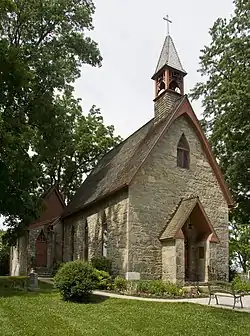St. Mark's Episcopal Church (Lappans, Maryland)
St. Mark's Episcopal Church is a historic Episcopal church located at Boonsboro, Washington County, Maryland, United States. Originally formed within Saint John's Parish, it was incorporated into Antietam Parish in 1899.
St. Mark's Episcopal Church-Lappans | |
 | |
  | |
| Location | 18313 Lappans Rd., Boonsboro, Maryland |
|---|---|
| Coordinates | 39°33′3″N 77°44′3″W |
| Area | 2 acres (0.81 ha) |
| Built | 1849 |
| Architect | Morin, Upton |
| Architectural style | Gothic Revival |
| NRHP reference No. | 99000931[1] |
| Added to NRHP | August 5, 1999 |
The original portion of the church was built in 1849 and is rectangular in shape, with two-foot-thick walls, 17 feet tall, constructed of rough-cut native limestone. It is enclosed by a stone wall which was built in 1922 and surrounded on its eastern, southern, and western sides by a cemetery of 173 markers. The church features a wooden portico covered with a wooden Gothic Revival roof and a steeple, which rises another 12 feet and includes the original bell and electronic carillon.[2] The building was closed for a brief period following the Battle of Antietam in 1862, but was reopened and has held services continuously ever since.
It was listed on the National Register of Historic Places in 1999 as "St. Mark's Episcopal Church-Lappans."[1] The church has more recently explored the role of slaves, slave owners, and freed slaves in its history.[3]
References
- "National Register Information System". National Register of Historic Places. National Park Service. July 9, 2010.
- Karl R. Sanford (October 1998). "National Register of Historic Places Registration: St. Mark's Episcopal Church-Lappans" (PDF). Maryland Historical Trust. Retrieved 2016-01-01.
- Amt, Emilie (March 2017). "Down from the Balcony: African Americans and Episcopal Congregations in Washington County, Maryland, 1800-1864 1". Anglican and Episcopal History. 86 (1).
External links
- Church website
- St. Mark's Episcopal Church-Lappans, Washington County, including photo from 1973, at Maryland Historical Trust

